EUR/USD
The Euro was blocked in the 1.4520 area against the dollar in Europe on Tuesday and subjected to heavy selling pressure with a test of support below 1.44 as risk appetite deteriorated. European equities surrendered initial gains which damaged confidence and there was a weaker than expected Italian bond auction result which increased fears surrounding the Euro-zone structural outlook. There was also a weak reading for Euro-zone business confidence which maintained fears over the growth outlook.
There were further reports that the ECB was again buying peripheral bonds which helped stem selling pressure on the Euro and there was further speculation over sovereign demand for the currency.
The US consumer confidence data was even weaker than expected with a decline to 44.5 for August from a revised 59.2 the previous month which was the lowest reading since April 2009 and reinforced fears over the economic outlook, especially with increased pessimism over the employment outlook.
The latest labour-market data will be watched closely on Wednesday and will be significant in setting the market tone ahead of Friday’s monthly payroll report.
The latest FOMC minutes suggested that there was lively discussion at the last Fed meeting with a clear divergence in view. The dissenters were uncomfortable with a commitment to keeping low interest rates until 2013 and Kocherlakota emphasised his inflation concerns in a speech on Tuesday. In contrast, some members of the FOMC wanted further policy action at this time. The minutes also confirmed the decision to hold a two-day meeting in September.
The minutes undermined the dollar slightly and there will be speculation over additional action, although the impact was measured with the US currency gaining some month-end support as the Euro struggled to regain the 1.4450 level.

Source: VantagePoint Intermarket Analysis Software
Call now and you will be provided with FREE recent forecasts
that are up to 86% accurate * 800-732-5407
If you would rather have the recent forecasts sent to you, please go here
Yen
The dollar was unable to make any headway during Tuesday with further tough resistance close to the 77 level and the US currency dipped to test support near the 76.50 level. The yen proved resilient during the day even when there was an improvement in risk appetite.
The latest Japanese economic data was slightly weaker than expected with the PMI manufacturing index falling to 51.9 from 52.1 while the industrial production increase was also lower than expected at 0.6% for the month which will tend to increase fears that economic recovery is stalling.
The government announced that it would announce additional steps to weaken the Japanese currency over the next few weeks, but the yen was still resilient with increased demand from exporters underpinning the currency in Asia on Wednesday.
Sterling
Sterling was unable to move above the 1.64 level against the US dollar during Tuesday and was subjected to renewed selling pressure during the European session with a test of support near 1.6250. There was a further weakening of safe-haven demand for the UK currency and there was some month-end Sterling selling which also had a negative impact as the Euro tested resistance levels above 0.8850.
The UK lending data remained subdued with a net GBP0.7bn increase in personal lending for July and money supply growth also remained lacklustre, although the mortgage approvals data was slightly stronger than expected.
The data impact was limited, but reinforced expectations that the Bank of England will maintain a very loose monetary policy which will continue to limit Sterling support. The PMI data will be very important for sentiment on Thursday and any further deterioration would undermine confidence in the economic outlook.
Swiss franc
The dollar found support close to 0.8110 against the franc on Tuesday and pushed to re-test resistance above 0.82 during the European session, but it was unable to sustain the gains. The Euro also dipped to test support near 1.1750 before consolidating close to 1.18, with an underlying weakening in demand for the Swiss currency still a feature.
There were further concerns surrounding the Euro-zone structural outlook which curbed further selling pressure on the Swiss franc. There were no suggestions of fresh measures to weaken the franc in comments from National Bank member Jordan, but markets remained on high alert, especially with fears within the small-business sector over damage caused by the strong currency.

Source: VantagePoint Intermarket Analysis Software
Call now and you will be provided with FREE recent forecasts
that are up to 86% accurate * 800-732-5407
If you would rather have the recent forecasts sent to you, please go here
Australian dollar
The Australian dollar initially hit resistance close to 1.0680 against the US dollar on Tuesday and initially retreated to lows near 1.0620 before challenging resistance in the 1.07 region.
The latest private-sector consumer credit data was in line with expectations with a 0.2% increase for July after a 0.1% decline the previous month which will maintain concerns over the domestic economic outlook.
Markets looked to take a more optimistic tone on risk appetite, but Asian equity markets were still struggling to make much headway which curbed demand for the Australian currency.



